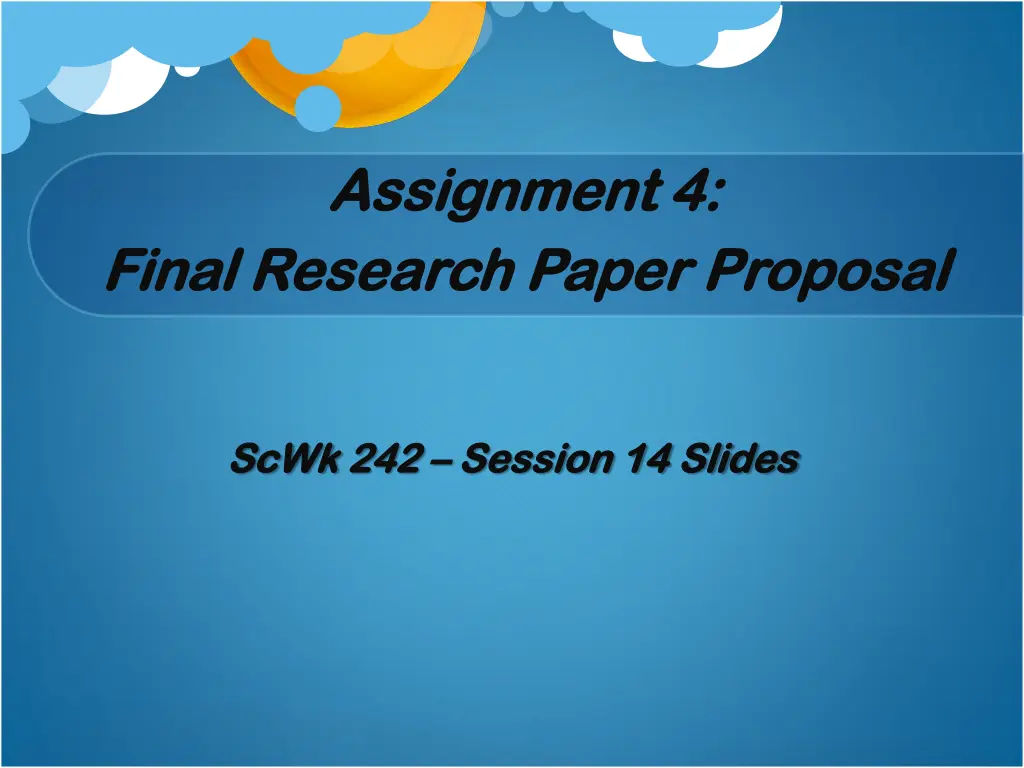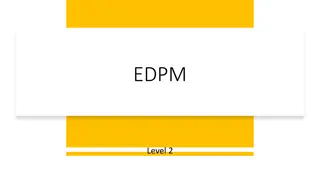
Research Design Choices in Social Work Studies
Explore the rationale behind selecting quantitative and qualitative research designs for a proposed study, along with sampling methods, sample size considerations, study site details, and measures/instrumentation for the quantitative portion. Gain insights into the reliability and validity aspects of the study instrument in the context of social work research.
Download Presentation

Please find below an Image/Link to download the presentation.
The content on the website is provided AS IS for your information and personal use only. It may not be sold, licensed, or shared on other websites without obtaining consent from the author. If you encounter any issues during the download, it is possible that the publisher has removed the file from their server.
You are allowed to download the files provided on this website for personal or commercial use, subject to the condition that they are used lawfully. All files are the property of their respective owners.
The content on the website is provided AS IS for your information and personal use only. It may not be sold, licensed, or shared on other websites without obtaining consent from the author.
E N D
Presentation Transcript
Assignment 4: Assignment 4: Final Research Paper Proposal Final Research Paper Proposal ScWk ScWk 242 242 Session 14 Slides Session 14 Slides
2 Methods Methods & Research & Research Design Design Identify and describe the Identify and describe the quantitative and the qualitative research designs and the qualitative research designs that you are proposing. Provide a brief that you are proposing. Provide a brief rationale for why you chose these rationale for why you chose these research designs to study your topic. research designs to study your topic. What are some quantitative designs? What are some quantitative designs? What are some qualitative designs? What are some qualitative designs? quantitative
3 Sample Sample Identify and describe the sampling method you are Identify and describe the sampling method you are proposing for the quantitative and qualitative portions proposing for the quantitative and qualitative portions of the proposed study (i.e., simple random sampling, of the proposed study (i.e., simple random sampling, convenience sampling, etc.) convenience sampling, etc.) Indicate the anticipated sample size for quantitative Indicate the anticipated sample size for quantitative and qualitative samples and qualitative samples Describe (in general) the anticipated demographic Describe (in general) the anticipated demographic characteristics of your quantitative and qualitative characteristics of your quantitative and qualitative samples samples
4 Study Site Study Site Identify and describe where your Identify and describe where your study will take place, including study will take place, including city and state and, if applicable, city and state and, if applicable, agency name. agency name.
5 Measures and Instrumentation Measures and Instrumentation For the For the quantitative quantitative portion of the proposed study portion of the proposed study: : Identify and describe the Identify and describe the operational definition measured) for the independent and the dependent variables. measured) for the independent and the dependent variables. Describe the Describe the type of quantitative study instrument type of quantitative study instrument being used, such as a survey, a case record review form, or if the data are such as a survey, a case record review form, or if the data are supposed to come from administrative data, indicate that here. supposed to come from administrative data, indicate that here. Describe Describe the reliability of the quantitative study instrument the reliability of the quantitative study instrument, if known. If not known, then describe how you would address known. If not known, then describe how you would address reliability issues (e.g. how will you know if the instrument is reliability issues (e.g. how will you know if the instrument is reliable)? reliable)? Describe Describe the validity of the quantitative study instrument, the validity of the quantitative study instrument, if known. If not known, then describe how you would address known. If not known, then describe how you would address validity issues (e.g. how will you know if the instrument is valid)? validity issues (e.g. how will you know if the instrument is valid)? operational definition (e.g. how it is (e.g. how it is being used, , if if
6 For For the qualitative portion of the proposed study: the qualitative portion of the proposed study: Identify and describe Identify and describe the main domains that are to be the main domains that are to be explored explored (e.g. the main topics you are going to ask (e.g. the main topics you are going to ask about) about) Describe Describe the type of qualitative study instrument the type of qualitative study instrument being proposed, such as a semi being proposed, such as a semi- -structured interview guide, or a focus group guide. guide, or a focus group guide. Describe how potential issues related to the Describe how potential issues related to the credibility and trustworthiness credibility and trustworthiness of the data will be addressed addressed structured interview of the data will be
7 Human Subjects Considerations Human Subjects Considerations Describe how you will obtain informed consent, ensure Describe how you will obtain informed consent, ensure participants confidentiality or anonymity, protect them from harm, participants confidentiality or anonymity, protect them from harm, and submit your proposal to an IRB for review and approval. and submit your proposal to an IRB for review and approval. Data Collection Procedures Data Collection Procedures Describe, step by step, how you will: Describe, step by step, how you will: Recruit potential participants (if applicable) Recruit potential participants (if applicable) Collect data from participants Collect data from participants What will happen when you collect data (survey, interview What will happen when you collect data (survey, interview questions, audio recording, field notes, etc..) questions, audio recording, field notes, etc..) If the proposed study includes an intervention, describe the If the proposed study includes an intervention, describe the intervention in this section intervention in this section
Proposed Analysis Proposed Analysis For the For the quantitative quantitative portion: portion: Describe the types of Describe the types of descriptive statistics are proposing to use for each variable of interest, are proposing to use for each variable of interest, including: demographic variables, the independent including: demographic variables, the independent variable, the dependent variable and also any variable, the dependent variable and also any important extraneous (i.e. confounding) variables that important extraneous (i.e. confounding) variables that may influence the possible relationship between the may influence the possible relationship between the independent and the dependent variables. independent and the dependent variables. Describe the type of Describe the type of inferential statistics inferential statistics that you are proposing to use to test your hypothesis. proposing to use to test your hypothesis. descriptive statistics that you that you that you are
For the For the Qualitative Portion: Qualitative Portion: Describe your anticipated Describe your anticipated process for qualitative analysis qualitative analysis (i.e. ongoing, cyclical process of reading and re cyclical process of reading and re- - reading transcripts and field notes) reading transcripts and field notes) Describe the Describe the coding process coding process you will use (content, thematic, comparative, use (content, thematic, comparative, narrative), you can combine these narrative), you can combine these approaches. approaches. process for (i.e. ongoing, you will
10 Study Design Strengths and Study Design Strengths and Limitations Limitations Describe Describe the potential strengths and the potential strengths and limitations of your proposed methods. limitations of your proposed methods. Consider Consider strengths and limitations of each strengths and limitations of each component in the methods section, however component in the methods section, however describe here only the most important describe here only the most important strengths and limitations. strengths and limitations.
11 Anticipated Anticipated Findings and Findings and Implications Implications Include in a separate section Include in a separate section Briefly state what you expect your Briefly state what you expect your findings to be, and explain the findings to be, and explain the implications of your specific, implications of your specific, anticipated results for social work (i.e., anticipated results for social work (i.e., its influence on practice, policy, theory, its influence on practice, policy, theory, and/or future research). and/or future research).
12 Minimum of 15 References Although Although a majority of references are cited in a majority of references are cited in the literature review, the introduction and the literature review, the introduction and methods section can contain references as well methods section can contain references as well. . Appendices Appendices: This demographic questions, interview questions if demographic questions, interview questions if applicable or other applicable or other items and questions, copies items and questions, copies of your instruments, and/or other detailed of your instruments, and/or other detailed documentation relevant to your study. documentation relevant to your study. : This section contains your section contains your
13 Grading and Evaluation Grading and Evaluation Evaluation of writing: Evaluation of writing: Extensively edit your own paper and/or have Extensively edit your own paper and/or have others assist you. others assist you. Do not expect your instructor to edit your draft or Do not expect your instructor to edit your draft or final paper for you. final paper for you. It is your responsibility to read through the paper It is your responsibility to read through the paper to identify and fix errors. to identify and fix errors. The word program will usually show many of The word program will usually show many of these problems colored in red or green these problems colored in red or green FIX THEM! THEM! FIX
14 Linking Literature Review to Your Proposal Linking Literature Review to Your Proposal Make Make clear connections clear connections between: The information presented in your The information presented in your literature review Your Your research statement research statement ( This research examines . ) ( This research examines . ) Your Your hypothesis hypothesis (quantitative) and your (quantitative) and your research question question (qualitative) (qualitative) Is Is there a there a logical connection logical connection between the information that you present and your research information that you present and your research statement? statement? Can Can the the reader reader easily see easily see why your proposed study would be important to the field of social work would be important to the field of social work? ? between: literature review research between the why your proposed study
15 Writing: Technical Issues Writing: Technical Issues Do not use contractions in professional writing: - Don t should be: do not, etc ). When starting a sentence with a number, write the number out in words Affect vs. Effect: -- Affect is a verb or adverb, e.g., Youth in the foster care system are affected by a number of challenging situations. -- Effect is a noun or object, e.g., Multiple placement changes can have a number of negative effects on youth in the foster care system.
16 Writing: Technical Issues Writing: Technical Issues Paraphrase Paraphrase do not generally use quotes: do not generally use quotes: Paraphrasing means to use your own words to Paraphrasing means to use your own words to summarize and/or synthesize someone else s work summarize and/or synthesize someone else s work Only use a quote of a passage of text if it is of some Only use a quote of a passage of text if it is of some distinction or you are providing the definition of a distinction or you are providing the definition of a concept. concept. Paraphrasing is a skill that requires you to fully Paraphrasing is a skill that requires you to fully understand the meaning of the text you are citing. understand the meaning of the text you are citing. For more information see: For more information see: http http://owl.english.purdue.edu/owl/resource/619/1/ ://owl.english.purdue.edu/owl/resource/619/1/
17 Writing: Technical Issues Writing: Technical Issues Ensure adequate paragraph structure: Ensure adequate paragraph structure: Paragraphs should be at least Paragraphs should be at least three sentences (beginning (transition), sentences (beginning (transition), middle (content) and end middle (content) and end (conclusion) (conclusion) Paragraphs should focus on one Paragraphs should focus on one idea and should idea and should never than one page double spaced. than one page double spaced. three never be longer be longer
18 Writing Tips Writing Tips Lead the reader on a journey (tell a Lead the reader on a journey (tell a good story) about why the study that good story) about why the study that you are proposing is important. you are proposing is important. Common feedback: Common feedback: Re Re- -word to improve clarity word to improve clarity Use topic Use topic- -specific sub specific sub- -section headings headings Use transition sentences and phrases Use transition sentences and phrases to link ideas to link ideas section
19 Writing Tips Writing Tips Make Make sure to back up your statements with sure to back up your statements with references. If you say: Studies show references. If you say: Studies show Research indicates There should be at Research indicates There should be at least one reference after that sentence. least one reference after that sentence. Qualify whenever possible your own Qualify whenever possible your own interpretations about research evidence as interpretations about research evidence as possibilities, possibilities, rather than rather than facts. facts.
20 APA In APA In- -Text Citations Text Citations Properly cite secondary sources Properly cite secondary sources No & within in No & within in- -text citations When referencing in When referencing in- -text: text citations text: U Use se just the authors last name and date just the authors last name and date (no first names, book title, (no first names, book title, journal/article titles or presentation journal/article titles or presentation titles) titles)
21 APA In APA In- -Text Citations Text Citations Use page Use page numbers for direct quotes only numbers for direct quotes only Use et al., for in Use et al., for in- -text citations only after you text citations only after you have already listed out all of the authors have already listed out all of the authors there are 6 or fewer authors (if more than 6, use there are 6 or fewer authors (if more than 6, use et al. the first time et al. the first time). ). if if If there are only two authors, each author is If there are only two authors, each author is listed listed every time every time
22 More APA Rules More APA Rules When describing a When describing a population rather than the disorder/problem: rather than the disorder/problem: population put the individual first, put the individual first, People with mental illness (vs. the mentally ill People with mental illness (vs. the mentally ill People with a substance use disorder vs. addicts, People with a substance use disorder vs. addicts, alcoholics etc alcoholics etc People with Autism vs. Autistics People with Autism vs. Autistics People who are undocumented or with unauthorized People who are undocumented or with unauthorized citizenship status vs. illegal immigrants citizenship status vs. illegal immigrants Etc . Etc .
23 Formatting Rules Formatting Rules Do Do not such as the author, this writer, etc. such as the author, this writer, etc. not use I, me, my, we, etc. use I, me, my, we, etc. - - Use the third person, Use the third person, Use 12 Use 12- -point Times New Roman font with 1 inch point Times New Roman font with 1 inch margins throughout margins throughout change bottom margin to .8 if change bottom margin to .8 if needed to ensure the margins area all the same size. needed to ensure the margins area all the same size. Set orphan and widow controls Set orphan and widow controls Use ragged right, not right Use ragged right, not right- -justified margins justified margins
24 Final Tips Final Tips The due date is the The due date is the last day of class on May 8 last day of class on May 8 Papers may be submitted via hardcopy in class, in my mailbox Papers may be submitted via hardcopy in class, in my mailbox that afternoon, or via e that afternoon, or via e- -mail that day mail that day Your instructor can provide one quick review of a draft Your instructor can provide one quick review of a draft submitted at least three days prior to the due date, but only if submitted at least three days prior to the due date, but only if your grade so far is B or less. your grade so far is B or less. Be sure to organize your work and stay on track Be sure to organize your work and stay on track do not wait until the day before the assignment is due. until the day before the assignment is due. do not wait Papers will be corrected within one week. You may give the Papers will be corrected within one week. You may give the instructor a self instructor a self- -addressed stamped envelope for mail addressed stamped envelope for mail- -back of hard copies. Electronic copies will be returned via e hard copies. Electronic copies will be returned via e- -mail. back of mail.






















